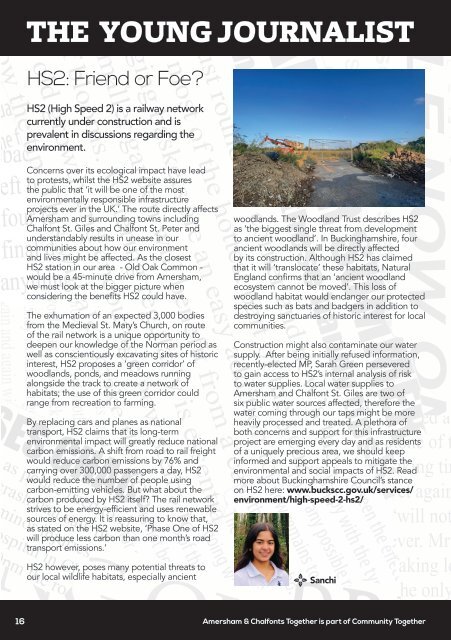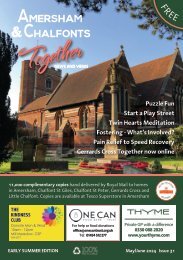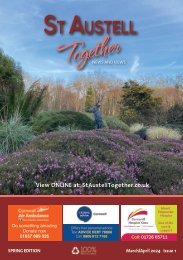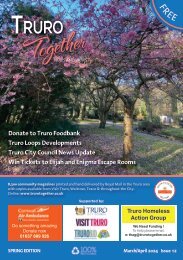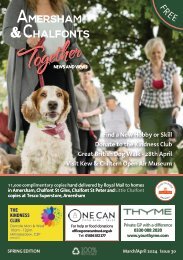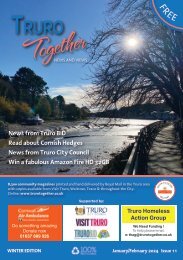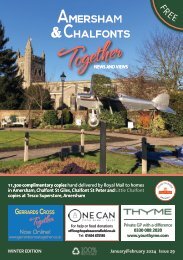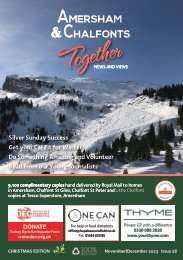Amersham and Chalfonts Together - September October 2021 Issue
#Community publication hand delivered to 15,300 homes and businesses via Royal Mail distribution in Amersham, Chalfont St Giles, Chalfont St Peter and Little Chalfont. News and views from non profit organisations, communities, charities, schools, with features on health, food, lifestyle, financial and much more. Please email us with latest news to: marketing@communitytogether.co.uk
#Community publication hand delivered to 15,300 homes and businesses via Royal Mail distribution in Amersham, Chalfont St Giles, Chalfont St Peter and Little Chalfont. News and views from non profit organisations, communities, charities, schools, with features on health, food, lifestyle, financial and much more. Please email us with latest news to: marketing@communitytogether.co.uk
Create successful ePaper yourself
Turn your PDF publications into a flip-book with our unique Google optimized e-Paper software.
THE YOUNG JOURNALIST<br />
HS2: Friend or Foe?<br />
HS2 (High Speed 2) is a railway network<br />
currently under construction <strong>and</strong> is<br />
prevalent in discussions regarding the<br />
environment.<br />
Concerns over its ecological impact have lead<br />
to protests, whilst the HS2 website assures<br />
the public that ‘it will be one of the most<br />
environmentally responsible infrastructure<br />
projects ever in the UK.’ The route directly affects<br />
<strong>Amersham</strong> <strong>and</strong> surrounding towns including<br />
Chalfont St. Giles <strong>and</strong> Chalfont St. Peter <strong>and</strong><br />
underst<strong>and</strong>ably results in unease in our<br />
communities about how our environment<br />
<strong>and</strong> lives might be affected. As the closest<br />
HS2 station in our area - Old Oak Common -<br />
would be a 45-minute drive from <strong>Amersham</strong>,<br />
we must look at the bigger picture when<br />
considering the benefits HS2 could have.<br />
The exhumation of an expected 3,000 bodies<br />
from the Medieval St. Mary’s Church, on route<br />
of the rail network is a unique opportunity to<br />
deepen our knowledge of the Norman period as<br />
well as conscientiously excavating sites of historic<br />
interest, HS2 proposes a ‘green corridor’ of<br />
woodl<strong>and</strong>s, ponds, <strong>and</strong> meadows running<br />
alongside the track to create a network of<br />
habitats; the use of this green corridor could<br />
range from recreation to farming.<br />
By replacing cars <strong>and</strong> planes as national<br />
transport, HS2 claims that its long-term<br />
environmental impact will greatly reduce national<br />
carbon emissions. A shift from road to rail freight<br />
would reduce carbon emissions by 76% <strong>and</strong><br />
carrying over 300,000 passengers a day, HS2<br />
would reduce the number of people using<br />
carbon-emitting vehicles. But what about the<br />
carbon produced by HS2 itself? The rail network<br />
strives to be energy-efficient <strong>and</strong> uses renewable<br />
sources of energy. It is reassuring to know that,<br />
as stated on the HS2 website, ‘Phase One of HS2<br />
will produce less carbon than one month’s road<br />
transport emissions.’<br />
HS2 however, poses many potential threats to<br />
our local wildlife habitats, especially ancient<br />
woodl<strong>and</strong>s. The Woodl<strong>and</strong> Trust describes HS2<br />
as ‘the biggest single threat from development<br />
to ancient woodl<strong>and</strong>’. In Buckinghamshire, four<br />
ancient woodl<strong>and</strong>s will be directly affected<br />
by its construction. Although HS2 has claimed<br />
that it will ‘translocate’ these habitats, Natural<br />
Engl<strong>and</strong> confirms that an ‘ancient woodl<strong>and</strong><br />
ecosystem cannot be moved’. This loss of<br />
woodl<strong>and</strong> habitat would endanger our protected<br />
species such as bats <strong>and</strong> badgers in addition to<br />
destroying sanctuaries of historic interest for local<br />
communities.<br />
Construction might also contaminate our water<br />
supply. After being initially refused information,<br />
recently-elected MP, Sarah Green persevered<br />
to gain access to HS2’s internal analysis of risk<br />
to water supplies. Local water supplies to<br />
<strong>Amersham</strong> <strong>and</strong> Chalfont St. Giles are two of<br />
six public water sources affected, therefore the<br />
water coming through our taps might be more<br />
heavily processed <strong>and</strong> treated. A plethora of<br />
both concerns <strong>and</strong> support for this infrastructure<br />
project are emerging every day <strong>and</strong> as residents<br />
of a uniquely precious area, we should keep<br />
informed <strong>and</strong> support appeals to mitigate the<br />
environmental <strong>and</strong> social impacts of HS2. Read<br />
more about Buckinghamshire Council’s stance<br />
on HS2 here: www.buckscc.gov.uk/services/<br />
environment/high-speed-2-hs2/<br />
Sanchi<br />
16 <strong>Amersham</strong> & <strong>Chalfonts</strong> <strong>Together</strong> is part of Community <strong>Together</strong>


